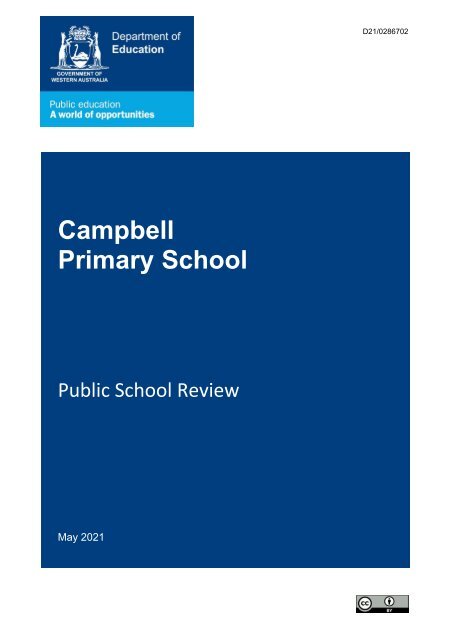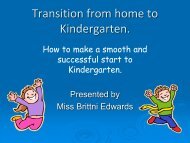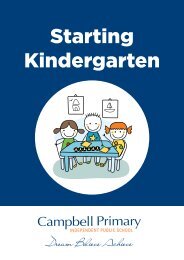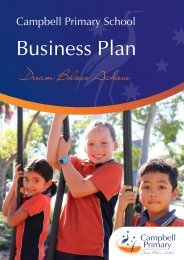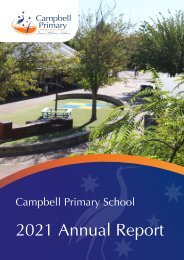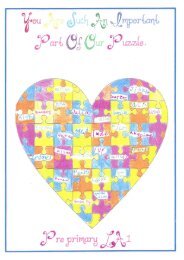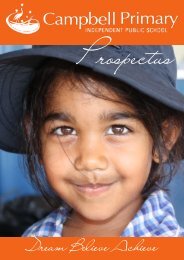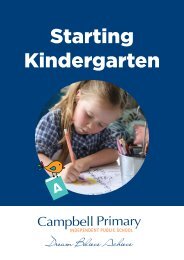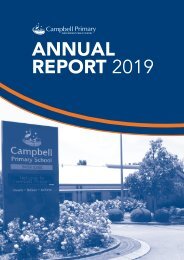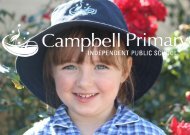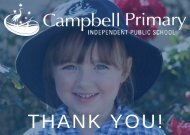Campbell Primary School Public School Review Report May 2021
You also want an ePaper? Increase the reach of your titles
YUMPU automatically turns print PDFs into web optimized ePapers that Google loves.
D21/0286702<br />
<strong>Campbell</strong><br />
<strong>Primary</strong> <strong>School</strong><br />
<strong>Public</strong> <strong>School</strong> <strong>Review</strong><br />
<strong>May</strong> <strong>2021</strong>
PUBLIC SCHOOL REVIEW<br />
Purpose<br />
All Western Australian public schools are reviewed by the Department of Education’s<br />
<strong>Public</strong> <strong>School</strong> Accountability directorate. A review gives assurance to the local community, the<br />
Minister for Education and Training and the Director General about the performance of public<br />
schools in delivering high quality education to its students. The review acknowledges the<br />
achievements of the school and gives feedback to support the Principal and staff with their<br />
improvement planning.<br />
Initially conducted on a three-year cycle, subsequent reviews are determined to occur on a one,<br />
three or five-year timeframe.<br />
The Principal provides the review team with a self-assessment of the school’s performance<br />
based on evidence from the school. Information to be validated by the review team is considered<br />
before and during the school visit. This forms the basis for the school review report and<br />
determines when the next review will occur. The report is provided to the Principal, the Chair of<br />
the <strong>School</strong> Council/Board and the regional Director of Education.<br />
Expectations of schools<br />
The Statement of Expectation (Statement) makes clear and public the expectations and<br />
responsibilities of schools and the Department in student achievement and progress.<br />
The Statement is between; the Department of Education, represented by the Director General;<br />
the school, represented by the Principal; and is noted by the school council/board, represented<br />
by the Chair.<br />
The Statement sets out the expectations of Principals in relation to the delivery of the 2020-2024<br />
strategic directions Every student, every classroom, every day, and Building on Strength.<br />
The Statement will underpin each school’s strategic planning and self-assessment and will form<br />
part of the school’s <strong>Public</strong> <strong>School</strong> <strong>Review</strong>, as well as the Professional Performance <strong>Review</strong> of the<br />
Principal.<br />
<strong>Public</strong> <strong>School</strong> <strong>Review</strong> – The Standard<br />
A Standard has been developed across the domains of the <strong>School</strong> Improvement and<br />
Accountability Framework to describe essential indicators of performance. The selection of the<br />
indicators is based on literature research and historical reviews of school performance in Western<br />
Australian public schools.<br />
The purpose is to better ensure that judgements about student performance are standardised<br />
and objective. Indicators describe what is evident in schools functioning ‘as expected’ within each<br />
domain.<br />
The Standard defines the expected level of school performance. Judgements are made in<br />
relation to the Standard. External validation is also based on evidence presented relating to the<br />
Standard.<br />
https://creativecommons.org/licenses/by/4.0/<br />
For further information or resource in alternative formats for people with accessibility needs, please contact<br />
<strong>Public</strong><strong>School</strong>Accountability.<strong>Public</strong><strong>School</strong><strong>Review</strong>@education.wa.edu.au<br />
2 PUBLIC SCHOOL REVIEW | REPORT
Context<br />
<strong>Campbell</strong> <strong>Primary</strong> <strong>School</strong> opened in 2002. Located in the suburb of Canning Vale, approximately<br />
20 kilometres south of the Perth central business district, the school is situated in the South<br />
Metropolitan Education Region.<br />
The school has an Index of Community Socio-Educational Advantage of 1089 (decile 2).<br />
<strong>Campbell</strong> <strong>Primary</strong> <strong>School</strong> gained Independent <strong>Public</strong> <strong>School</strong> status in 2010. There are currently<br />
571 students enrolled from Kindergarten to Year 6.<br />
Specialist learning programs are offered in drama, music, visual arts, physical education, science<br />
and Italian. The student population is diverse, with over 50 per cent of students with a language<br />
background other than English.<br />
The Parents and Citizens’ Association (P&C) works with the community to fundraise to support<br />
school initiatives and programs. The <strong>School</strong> Board plays an active role in the development and<br />
endorsement of the school’s business plan and strategic planning.<br />
<strong>School</strong> self-assessment validation<br />
The Principal submitted a comprehensive and rigorous school self-assessment.<br />
The following aspects of the school’s self-assessment process are confirmed:<br />
<br />
<br />
<br />
<br />
<br />
<br />
<br />
Sophisticated self-review processes and the analysis of data are embedded practice,<br />
informing ongoing planning and implementation of school and system initiatives.<br />
The whole-school assessment schedule is aligned to the domains of the <strong>School</strong><br />
Improvement and Accountability Framework, with responsibilities for data collection and<br />
monitoring articulated.<br />
Comprehensive and embedded self-assessment processes supported the school to prepare<br />
for the <strong>Public</strong> <strong>School</strong> <strong>Review</strong>.<br />
Staff actively engaged with the Electronic <strong>School</strong> Assessment Tool (ESAT) for regular wholeschool<br />
self-assessment processes. Consultative practices, moderation and explicit selfreflection<br />
were hallmarks of the processes used to determine entries and evidence sources.<br />
A summary statement provided an overview of the school’s performance aligned to each of<br />
the foci indicated within the domains of the Standard.<br />
A broad scope of interrelated and credible evidence was selected for the ESAT submission,<br />
with clear alignment between performance evidence and planned actions.<br />
A wide range of staff, student, parent and community representatives engaged in discussion<br />
with the review team, contributing authentic reflections in support of the school and its<br />
improvement journey.<br />
3 PUBLIC SCHOOL REVIEW | REPORT
<strong>Public</strong> <strong>School</strong> <strong>Review</strong><br />
Relationships and partnerships<br />
The key values of respect, kindness and resilience underpin a strong and positive school culture. With the<br />
overarching intent on high quality learning for all students, transparent leadership enables professionally<br />
respectful relationships to flourish.<br />
Commendations<br />
The review team validate the following:<br />
Embedded PLC 1 s are a feature of the school. A strong culture of collaboration exists, with group norms for<br />
teams and a leadership model in place to ensure the focus is on student learning and improvement.<br />
Induction processes are comprehensive, ensuring the collaborative culture is maintained.<br />
Inclusive, supportive and comprehensive communication processes and protocols are established for<br />
staff and families.<br />
Feedback from parents and carers is valued and sought through a range of platforms. High levels of<br />
satisfaction from all key stakeholders are evidenced and the data used to inform school plans and practice.<br />
<strong>School</strong> Board members are knowledgeable, representative of the local community and provide valued<br />
perspectives, advocacy and governance. Their connections with local industry and organisations<br />
facilitate the formation of valuable partnerships.<br />
Building community through genuine opportunities to come together is a key role of the P&C, which<br />
provides significant financial support for the school’s key initiatives.<br />
The school embraces network partnerships to further build staff capacity and leadership opportunities.<br />
Learning environment<br />
The learning environment, designed to maximise student engagement, inclusion and genuinely welcome<br />
families as partners in their child’s learning journey, has set the conditions to sustain a strong culture of<br />
educational excellence.<br />
Commendations<br />
The review team validate the following:<br />
The school environment is well maintained, modern and engaging. Staff and students take pride in their<br />
school, with clear policies, processes and programs in place to support attendance, behaviour and<br />
engagement of all students.<br />
A focus on using creativity as a pedagogical tool for learning is cultivated through the Creative <strong>School</strong>s<br />
program. Meaningful partnerships encourage the development of academic, social and personal skills.<br />
High levels of attendance are evidenced across all year levels. Processes are in place to monitor<br />
attendance and late arrivals, with appropriate supports and plans established.<br />
Underpinned by recognition of positive behaviour, there are strong and consistent approaches to<br />
behaviour management, with clear expectations of all stakeholders identified throughout policy.<br />
Student wellbeing approaches are comprehensive and supported by the Highway Heroes resource. Zones<br />
of Regulation is implemented to actively support students to identify and regulate their emotions.<br />
The Kindergarten to Year 2 phase of learning team explicitly plans innovative and engaging learning<br />
experiences for students in the outdoor environment.<br />
Professional learning, a wellbeing hub and significant resources are prioritised to enhance the<br />
unwavering focus on staff support and wellbeing.<br />
Clear processes are in place to identify, monitor and support all students at educational risk. The Student<br />
Services Team plays a pivotal role in supporting students, teachers and families.<br />
The school recognises that an active student voice is essential to the development of a positive and truly<br />
representative culture and this is being fostered in a variety of ways.<br />
4 PUBLIC SCHOOL REVIEW | REPORT
Leadership<br />
Reflective of the school’s mission, vision and values, a targeted focus on students and what is in their best<br />
interest underpins all decision making. The Principal expertly leads an explicit improvement journey, with<br />
clear alignment of the business plan, school improvement, and operational and classroom planning.<br />
Commendations<br />
The review team validate the following:<br />
Through the year level PLC structures, there is collective responsibility for student improvement, with<br />
staff ensuring ongoing implementation, monitoring and review of year level plans.<br />
Change is managed carefully and strategically. Highly consultative approaches, underpinned by<br />
evidence, support and student need, are hallmarks of the school’s effective improvement journey.<br />
The distribution of leadership across the school is exceptional and has created an environment in which<br />
staff have ownership of school priorities, processes and student learning. The Principal has provided<br />
instructional support to team leaders in the development of highly effective PLCs.<br />
Curriculum area leaders, with the support of the executive team, drive strategic and operational planning<br />
across the school. An operational plan linked to the business plan has been developed within each<br />
curriculum area, with clear targets, core agreements and strategies that drive whole-school connected<br />
practices.<br />
Team leaders work collaboratively to coach and share their ideas on managing teams, data collection,<br />
agenda items and developing their leadership in this role.<br />
Involvement in the Aspirant Leader program across the network reflects <strong>Campbell</strong> <strong>Primary</strong> <strong>School</strong>’s<br />
commitment to talent identification and support of the Department of Education’s leadership initiatives.<br />
A clear and embedded approach to performance review is in place. This includes staff reflecting upon<br />
their practice against the AITSL 2 Australian Professional Standards for Teachers, identifying possible<br />
areas for growth, determining a goal and engaging in review against their goal setting.<br />
Use of resources<br />
Financial management and future-based planning support staff to provide the best possible learning<br />
opportunities for students. Embedded financial processes and procedures ensure appropriate oversight of<br />
the school’s human, physical and fiscal resources, with transparent alignment to planning.<br />
Commendations<br />
The review team validate the following:<br />
Sophisticated monitoring tools are used to manage the school’s one-line budget, supporting informed<br />
decision making in consultation with the Finance Committee and <strong>School</strong> Board.<br />
Mutually beneficial deed of license arrangements exist that support the school community and deliver<br />
significant financial support to the school.<br />
Technologies are prioritised through sound management of resources, implementation of 1:1 Bring Your<br />
Own Device programs and leasing arrangements. The targeted leasing of technologies ensures access<br />
to current technology on a cyclical basis across the school.<br />
Health and safety officers provide current and prudent reports that are used to address school faults,<br />
breakages and safety concerns.<br />
Targeted initiative and student characteristics funding are used strategically to provide support in<br />
teaching and learning programs. There are transparent and clear links between funding and plans to<br />
address learning outcomes for students.<br />
A future-based workforce plan enables analysis of the staffing requirements, recruitment and the need for<br />
succession planning. Planning processes are supported by comprehensive tools and documentation.<br />
5 PUBLIC SCHOOL REVIEW | REPORT
Teaching quality<br />
Staff demonstrate a professional responsibility and personal commitment to excellence in teaching, and<br />
understand that high quality teaching has the most impact on improving student achievement. The use of<br />
data within PLCs to inform pedagogy and systematic curriculum delivery, is a feature of the school.<br />
Commendations<br />
The review team validate the following:<br />
Supported by team leaders and curriculum coaches, the highly collegiate culture of the school is driven<br />
by a unified focus and collaboration on student learning.<br />
Planning on a whole-school and year level basis is driven by data and evidence-based practice. Wholeschool<br />
expectations are explicit.<br />
Connected practices are embedded across the school. The implementation of the iSTAR 3 pedagogical<br />
model supports the consistent delivery of curriculum and teaching practice. Staff commit to core<br />
agreements, and the common language of visible learning is embedded, including We are learning to<br />
(WALT) and What I’m looking for (WILF).<br />
Teachers engage in task design, moderation processes and professional dialogue enabling them to<br />
make informed and consistent judgements about teaching and learning in the classroom.<br />
Underpinned by a mission statement and core agreements aligned to the Aboriginal Cultural Standards<br />
Framework reflections, teachers embed Aboriginal perspectives into their classroom practice. Staff<br />
regularly review their progress and determine a common focus area for future growth.<br />
A clear and transparent Assessment and <strong>Report</strong>ing policy underpins the provision of accurate and<br />
informed feedback to parents on a regular basis, in a range of platforms.<br />
A concerted and considered effort ensures that all professional learning directly relates to the business<br />
plan and the priority areas within.<br />
Student achievement and progress<br />
A range of systemic and school-based data is expertly collected and analysed in order to track student<br />
achievement and progress. There is a focus on collective responsibility for the achievement and progress of<br />
all students, with regular and consistent review aligned to targets.<br />
Commendations<br />
The review team validate the following:<br />
On-entry Assessment Program data is used by teachers to provide a differentiated curriculum to their<br />
students, including targeted intervention and extension approaches.<br />
System and school-based data is used to identify students who need further intervention in the form of<br />
MiniLit or case management. Data sets also inform additional referral processes to the Student Services<br />
Team.<br />
Across the school, English as an Additional Language or Dialect (EAL/D) student progress and<br />
achievement is mapped using the EAL/D Progress Map. Where required, students are provided with<br />
specifically identified interventions, and support through the ethnic assistant.<br />
The levels of Aboriginal student achievement are explicitly monitored through the Student Services Team<br />
to ensure all students reach and attain respective levels of achievement, in literacy and numeracy.<br />
Year 5 stable cohort data, NAPLAN 4 (2017-2019), indicate high progress and high achievement in<br />
Grammar and Punctuation and Spelling. Low progress but high achievement in all other assessed areas<br />
is evident.<br />
2019 NAPLAN results against like schools revealed that <strong>Campbell</strong> <strong>Primary</strong> <strong>School</strong> Year 3 and 5<br />
achievement levels were above that of like schools.<br />
6 PUBLIC SCHOOL REVIEW | REPORT
<strong>Review</strong>ers<br />
Rebecca Bope<br />
Director, <strong>Public</strong> <strong>School</strong> <strong>Review</strong><br />
Geoffrey Smith<br />
Principal, Currambine <strong>Primary</strong> <strong>School</strong><br />
Peer <strong>Review</strong>er<br />
Endorsement<br />
Based on this report, I endorse the commendations made by the review team regarding your<br />
school’s performance.<br />
Your next school review is scheduled for Term 2, 2026.<br />
Melesha Sands<br />
Deputy Director General, <strong>School</strong>s<br />
References<br />
1 Professional Learning Community<br />
2 Australian Institute for Teaching and <strong>School</strong> Leadership<br />
3 Framework for professional learning and teaching: “Inform/Inspire, Show/Share, Try/Transfer, Apply/Act,<br />
<strong>Review</strong>/Revise”<br />
4 National Assessment Program – Literacy and Numeracy<br />
7 PUBLIC SCHOOL REVIEW | REPORT


